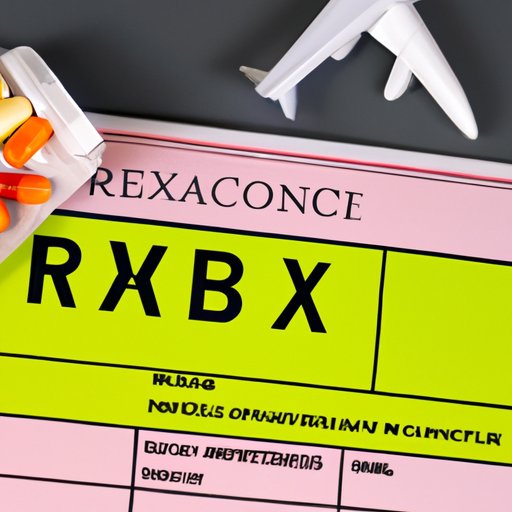
Introduction
If you take prescription medicine and are planning to travel by plane, you might be wondering about the rules and regulations around carrying your medication on board. In this guide, we’ll explore everything you need to know about bringing prescription medication on a plane, including TSA regulations and recommendations for packing and traveling with medication.
The Importance of Knowing TSA Regulations for Travelers Who Take Prescription Medicine
Knowing TSA regulations related to medication is crucial when traveling, especially for those who take prescription medicine. According to TSA, prescription drugs are allowed on board, but there are specific rules to follow to ensure that you can travel safely and legally.
Not following TSA rules can result in detention or missed flights, so understanding and adhering to these rules are essential. It is vital to know exactly what you can and cannot carry, as well as how to deal with different scenarios that may come up during your travels.
Navigating the Dos and Don’ts of Bringing Prescription Medication on a Flight
Here’s what you can and cannot do when bringing prescription medication on a flight:
- You can carry medication in both your carry-on and checked luggage.
- You do not need to declare medication in your checked luggage, but you should declare it at the security checkpoint.
- Medication containers should be labeled with the passenger’s name and prescription information.
- If you’re carrying liquid medication, it must be kept in containers of 3.4 ounces or less and placed in a clear, sealable bag.
To make the process smoother, keep medications in their original packaging and bring a copy of your prescription with you. Additionally, if you use medical equipment, such as syringes, make sure they are properly packed and labeled.
What Every Traveler Needs to Know When Carrying Prescription Medicines on a Plane
When traveling with prescription medication, ensure that it is correctly packed for your flight. Put all your medication in your carry-on in case your checked bag is lost or delayed.
It’s essential to obtain a copy of your prescription from your doctor and bring your medications in their original packaging. These measures will assist customs officials in determining whether or not the medication is legal and should be allowed into the new country.
Your Guide to Traveling with Prescription Medications: Tips and Recommendations
When flying with prescription medication, there are a few things you should be aware of:
- Make sure you have enough medication to last the duration of your trip, plus some extra in case of delays.
- If you have a layover, keep your medication with you in your carry-on bag.
- In case of an emergency, bring a letter from your doctor describing your medical condition and the necessary treatment.
It’s also a good idea to research your destination country’s medication regulations before you travel.
Essential Information for Passengers Carrying Prescription Drugs on a Plane
There are specific situations you may encounter when flying with prescription medication:
- If your medication requires refrigeration, make sure the container is labeled with your name and prescription information.
- If you’re traveling with someone who takes prescription medication, make sure you keep each other’s medication separate to avoid mix-ups.
- If you’re traveling with a controlled substance, such as painkillers, make sure you have the appropriate documentation from your doctor.
If your medication is withheld by TSA, don’t panic. You’ll be given an X-ray slip or a pat-down that will allow you to board the aircraft as planned. The TSA may want to inspect medication more thoroughly, and this may cause a minor delay.
Packing for a Flight with Prescription Medication: A Step-by-Step Guide
When packing prescription drugs for a flight, follow these steps:
- Pack all your medication in your carry-on bag.
- Use the original packaging to pack your medication.
- Bring a copy of your prescription with you.
- For liquid medication, use a clear, sealable bag and ensure that your containers are 3.4 ounces or less.
- Label the medication containers with your name and prescription information.
The TSA recommends that you inform the security officer that you are carrying prescription medication before screening to guarantee that they know what to expect and can manage the medication properly.
Understanding the TSA Rules When Traveling with Prescription Medication
When traveling with prescription medication, familiarize yourself with the following TSA rules:
- You must declare all medically necessary liquids, aerosols, gels, and pastes at the checkpoint.
- Medication does not have to be labeled, but make sure to declare it and let the officer know if you are carrying it in quantities over 3.4 ounces.
- If you’re carrying a liquid medication, make sure it’s in 3.4 ounces or less containers and that you have a clear plastic bag to pack it in.
- If you’re traveling with a life-sustaining medication, such as an EpiPen, you can bring more than 3.4 ounces of medication, but you should declare it at the checkpoint.
Keep in mind that all rules and regulations can change in response to current events and that it’s important to stay up to date with TSA regulations and recommendations.
Conclusion
If you’re traveling with prescription medication, it’s essential to know the TSA regulations and recommendations. This guide has covered what you can and cannot do when it comes to bringing prescription medication on a flight and advice on how to make the process smoother. Remember to pack your medication safely with the original packaging and bring a copy of your prescription with you. By following these guidelines, you can travel safely and legally with prescription medication.





